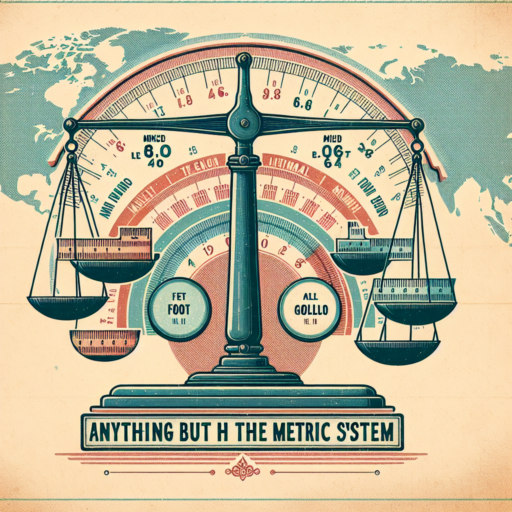Why do Americans use everything but the metric system?
The United States’ resistance to the metric system is one that perplexes many, particularly as most countries around the world have embraced it for its simplicity and universality. The American use of the Imperial system, also known as the U.S. Customary System, is grounded in the nation’s history, cultural identity, and pragmatism.
Rooted in History
America’s use of the Imperial system dates back to its founding. The original 13 colonies, established by the British, brought with them British units of measurement. Even after gaining independence, Americans continued to use these British measurements out of habit and convenience. While the metric system was later introduced, its adoption was never mandated at a federal level, leaving states and individuals free to use the measurement system they preferred.
A Matter of Identity
Another aspect that encourages the continued use of the Imperial system over the metric system in the United States is cultural identity. It is seen as part of the American tradition and independence, a way to differentiate the country from the rest of the world. For many, switching to the metric system can be perceived as yielding to international pressures and losing a part of their unique American identity.
Practical Considerations
Lastly, practicality plays a crucial role in America’s preference for the Imperial system. Retrofitting infrastructure, rewriting textbooks, retraining professionals – these are just a few examples of what transitioning to the metric system would entail. The perceived costs and complexities associated with such a massive change often outweigh the potential benefits, leading to continued resistance to the metric system.
What is there other than the metric system?
When delving into the world of sports watches, you could find yourself encountering more than just the metric system. While the metric system – which uses measures such as kilometers and meters – is the most universally recognized, there are other systems of measurement that have relevancy and significance for sports watch enthusiasts around the world.
The Imperial System vs. The Metric System
The Imperial system of measurement, predominately used in the United States, is one such alternative. This system incorporates units such as inches, feet, and miles, offering a different perspective than the metric system. Sports watches often feature both the metric and imperial system, allowing the user to switch between the two based on personal preference and understanding. This dual functionality ensures the users’ comfort and familiarity with their chosen measurement system.
Nautical Measures
Another alternative to the metric system found in sports watches is nautical measures. Designed for sailors and boating enthusiasts, these measures – including knots and nautical miles – provide specific value in maritime circumstances. Particularly, sports watches for aquatic sports and sailing often incorporate these measurements. Hence, aside from just the metric system, sports watches also cater to the needs and convenience of niche sports sections.
Ancient Measurement Systems
Last but not least, some luxury sports watchmakers even incorporate ancient measurement systems-maintaining a rare blend of modern functionality and timeless charm. The Roman, Greek, and Egyptian measurement systems, though not commonly used today, can be found in some high-end sports watches, giving them a unique touch of antiquity.
No se han encontrado productos.
What is the non-metric system called?
The non-metric system, often utilized in the United States among a few other countries, is referred to as the Imperial System of measurements. While the metric system has a unidimensional and universal application, measurements in the Imperial system vary based on the nature of the item being measured.
Key Components in the Imperial System
- Length: Techniques for quantifying length or distance incorporate inches, feet, yards, and miles.
- Weight: Ounces, pounds, stones, and tons are the standard units for measuring weight.
- Volume: Fluid ounces, pints, quarts, and gallons are used to calculate the volume of liquids.
This historical system of measurement, although less commonly used compared to the metric system, holds a paramount place in day-to-day measurements in certain regions. It’s pertinent to the realms such as construction, manufacturing and so forth in countries like the U.S., Liberia, and Myanmar. Although the adoption of the metric system has been urged for simplification and global uniformity, the inertia of customary usage has meant that the change has been slow to permeate these domains.
Considerations when dealing with the Non-Metric System
The conversion between units in the Imperial system is not as straightforward as in the Metric system where conversions equate to multiples of ten. For example, 1 foot equals 12 inches and 1 yard equals 3 feet or 36 inches. Hence, the complexity adds a layer when utilizing these measurements, necessitating conversion tools or intricate calculations. Despite its complexities, the Imperial system is integral to various cultural, historical, and industrial realms, thus maintaining its relevance even today.
What doesn’t use the metric system?
There exist several sectors and devices that still don’t use the metric system. One of these is the world of sports watches, particularly in the United States. For many users and manufacturers, the preference to use the imperial system – miles instead of kilometers, feet instead of meters – remains despite the metric system’s global acceptance.
Let’s take a closer examination at sports watches. Sports watches, designed for athletic individuals, often come with features like GPS, heart rate monitors, and distance trackers. Whether you are running, bicycling or swimming, these watches are designed for you. In the United States, these measurements are typically displayed using the imperial system.
Imperial system in Sports Watches:
- Distance tracking: When tracking the distance of your run or cycle, sports watches often display this in miles, not kilometers.
- Elevation: If the watch has an altimeter to measure height or elevation, this is again in feet, not meters.
- Speed calculation: For speed, miles per hour is often preferred over kilometers per hour.
It’s important to note that this doesn’t undermine the functionality or accuracy of the sports watches. Most sports watches allow users to switch between systems, catering to users’ preferences. However, the default for many American brands is the imperial system, offering a fascinating look at what doesn’t use the metric system.




